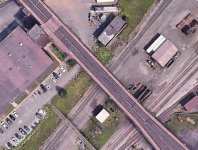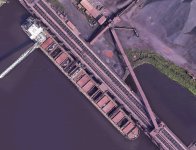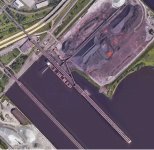Wondering if some folks can tell me how they switch the "Jennies" out on the oredocks meaning when the first few are done unloading what happens to them so they can continue to unload "Jennies" towards the back and how did that engine in previous video submitted by Mr Arly pull that load out on an oredock and appeared to do a three point turn and come off that oredock forward? I'm sure theres not a roundhouse 1k feet out on the lake? A railroad illiterate person like me has only ridiculous humorous ideas of what happened in that matter.
Not sure what you're asking.
Take a look at the dock from above. Maybe that'll answer your question?
There are double tracks out to the dock.
There is a switch between the double tracks before it goes out over the water.
In the video, the train pulled the cars up to the switch, dropped them there, switched over to the other track and went to the far end of the train.
My guess would be that they then pushed the Jennies out onto the dock as far as the ship is long, dumped the contents of those Jennie into the corresponding hoppers, then pushed it out further out onto the dock and repeated.
If they got to a point where they still had more Jennies to dump than the dock is long, they'd break the train, pull the empties off onto the other track, and then push the remaining full Jennies out onto the dock.
See screen shots below.
The switch

The dock used to be 4 tracks wide, but looks to be 3 now.

The hoppers under the tracks with the chutes to dump into the ship.

The entire length of the dock compared to the ship.






